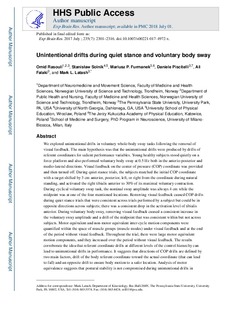Unintentional drifts during quiet stance and voluntary body sway
Rasouli, Omid; Solnik, Stanislaw; Furmanek, Mariusz P; Piscitelli, Daniele; Falaki, Ali; Latash, Mark L.
Journal article, Peer reviewed
Accepted version
Permanent lenke
http://hdl.handle.net/11250/2560609Utgivelsesdato
2017Metadata
Vis full innførselSamlinger
Sammendrag
We explored unintentional drifts in voluntary whole-body sway tasks following the removal of visual feedback. The main hypothesis was that the unintentional drifts were produced by drifts of referent coordinates for salient performance variables. Young healthy subjects stood quietly on a force platform and also performed voluntary body sway at 0.5 Hz both in the anterio-posterior and medio-lateral directions. Visual feedback on the center of pressure (COP) coordinate was provided and then turned off. During quiet stance trials, the subjects matched the initial COP coordinate with a target shifted by 3 cm anterior, posterior, left, or right from the coordinate during natural standing and activated the right tibialis anterior to 30% of its maximal voluntary contraction. During cyclical voluntary sway task, the nominal sway amplitude was always 4 cm while the midpoint was at one of the four mentioned locations. Removing visual feedback caused COP drifts during quiet stance trials that were consistent across trials performed by a subject but could be in opposite directions across subjects; there was a consistent drop in the activation level of tibialis anterior. During voluntary body sway, removing visual feedback caused a consistent increase in the voluntary sway amplitude and a drift of the midpoint that was consistent within but not across subjects. Motor equivalent and non-motor equivalent inter-cycle motion components were quantified within the space of muscle groups (muscle modes) under visual feedback and at the end of the period without visual feedback. Throughout the trial, there were large motor equivalent motion components, and they increased over the period without visual feedback. The results corroborate the idea that referent coordinate drifts at different levels of the control hierarchy can lead to unintentional drifts in performance. It suggests that directions of COP drifts are defined by two main factors, drift of the body referent coordinate toward the actual coordinate (that can lead to fall) and an opposite drift to ensure body motion to a safer location. Analysis of motor equivalence suggests that postural stability is not compromised during unintentional drifts in performance in contrast to earlier studies of multi-finger tasks. This may be due to the vital importance of postural stability for everyday actions.
